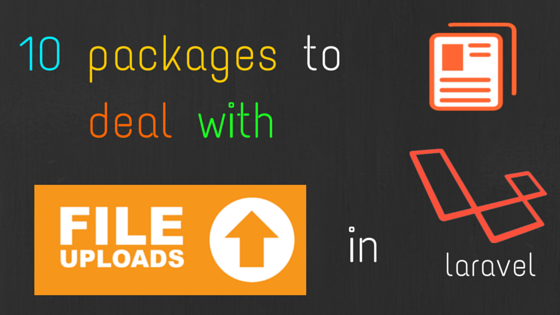#8 laravel-file-uploader
Web Form File Uploader for Laravel
Laravel File Uploader is a web form upload manager for Laravel 5.1. This package provides additional files for the craigh411/FileUploader package for use within the Laravel framework. FileUploader uses the same symfony/HttpFoundation package used by laravel for file uploads, so is easily integrated, but adds some additional functionality to make file uploads a breeze.
Features
- Allow and block specific mime types.
- Adjust maximum file size.
- Choose to automatically create upload directories.
- Allow file overwriting
- Automatically create sanitised file names.
- Create unique file names
Installation
Install via Composer with:
composer require craigh/laravel-file-uploader
or you can add:
"craigh/laravel-file-uploader": "~1.0"
to the require section of your composer.json file and run composer update from the command line.
You should also register the service provider by adding the following to providers in config/app.php:
HumpsLaravelFileUploaderFileUploaderServiceProvider::class
Creating an Alias (Optional)
While not required, if you want to use the facade you need to add the following to aliases in config/app.php:
'Upload' => HumpsLaravelFileUploaderFacadesUploaderFacade::class
You will then be able to use the Upload alias to use the facade.
Basic Usage
Beacuse LaravelFileUploader uses the symfony/HttpFoundation you can pass $request->file('input_name') directly into the file method.
If you’ve added the alias for the facade, then you can use:
Upload::file($request->file('file'))->move();
You will need to use Upload to get this to work if you are working inside a namespaced class.
If you are not using the facade you can type hint LaravelFileUploader in your classes methods or constructor or if you prefer you can simply call:
$upload = App::make('upload');
Changing Settings Directly
If you want to change the default settings then you can simply chain them together like so (See Methods at the bottom for the full settings list):
Upload::file($request->file('file')))
->createDirs(true)
->maxFileSize(5,'MB')
->allowedMimeTypes(['image/jpeg', 'image/png', 'image/gif'])
->move();
Note: The move() method returns the upload path, so must be chained to the end.
Configuring Using Inheritance
For a clean configuration you can extend the LaravelFileUploader class which gives you access to the following protected variables:
protected $uploadDir; // Upload directory
protected $allowedMimeTypes = []; // Only allow these file to be uploaded
protected $blockedMimeTypes = []; // Don't allow these files to be uploaded
protected $maxFileSize = 1000000; // In bytes
protected $makeFilenameUnique = false; // Make the filename unique if two files have the same name
protected $overwrite = false; // Allow overwriting of files with the same name
protected $createDirs = false; // Allow the automatic creation of any upload directories
e.g. For an ImageUploader you may do the following:
use HumpsLaravelFileUploaderLaravelFileUploader;
class ImageUploader extends LaravelFileUploader{
protected $uploadDir = 'images/';
protected $maxFileSize = 5+6e; // 5 MB
protected $createDirs = true;
protected $makeFilenameUnique = true;
protected $allowedMimeTypes = [
'image/jpeg',
'image/png',
'image/gif'
];
}
This can now be used in your classes which will automatically use those values as defaults:
/**
* Example using dependency injection
**/
private $upload;
public __constructor(ImageUploader $upload){
$this->upload = $upload;
}
public function store(Request $request){
$this->upload->file($request->file('file'))->move();
}
HumpsFileUploaderUploader Interface
You can also bind to the HumpsFileUploaderUploader interface. To do this place the following inside the register() method of your AppServiceProvider:
App::bind('HumpsFileUploaderContractsUploader','HumpsLaravelFileUploaderLaravelFileUploader');;
You can then type hint the interface instead of the concrete class:
use HumpsFileUploaderUploader;
private $upload;
public __constructor(Uploader $upload){
$this->upload = $upload;
}
Now you can swap out your own implementations simply by changing the bound class e.g.:
App::bind('HumpsFileUploaderContractsUploader','YourNamespaceYourFileUploader');;
Methods
uploadDir(string)
Sets the upload directory. It will also append any required ‘/’ if it is not set, so both ‘path/to/dir’ and ‘path/to/dir/’ will work.
$upload->uploadDir('path/to/dir');
Note: The public folder will be the base directory for your uploads, so if you set your upload path to ‘images’ ($upload->uploadDir('images');) this will upload to the public/images folder.
overwrite(boolean)
Set to true to allow overwriting of files with the same name (default: false)
$upload->overwrite(true);
allowedMimeTypes(array)
Pass in an array of allowed mime types, everything else will be blocked. When empty all file types will be allowedunless explicitly blocked.
$upload->allowedMimeTypes(['image/jpeg, 'image/png', 'image/gif']);
blockedMimeTypes(array)
You can also block file types if you prefer. Pass in an array of mime types you want to block
$upload->blockedMimeTypes(['application/x-msdownload']);
maxFileSize($size, $unit)
The maximum file size you want to allow, expects size to be a number and unit to be either:
- B – Byte
- KB – Kilobyte
- MB – Megabyte
$upload->maxFileSize(5, 'MB');
You can also use the words BYTE, BYTES, KILOBYTE, KILOBYTES, MEGABYTE or MEGABYTES if you prefer:
$upload->maxFileSize(1, 'MEGABYTE');
createDirs(bool)
If set to true this will recursively create any specified directories if they do not exist (default: false)
$upload->createDirs(true);
makeFilenameUnique(bool)
If set to true this will make the filename unique by appending a _{number} to the end.
$upload->makeFilenameUnique(true);
filename(string)
By default the filename will be a sanitised version of the uploaded filename. Use this method if you want to set your own filename.
$upload->filename('myFile.txt');
Note: When using this method the filename will not be sanatised, if you want to sanatise the filename you can use the sanitizeFilename() method.
sanitizeFilename()
Sanitises the given filename by removing any non alpha numeric characters and replacing any spaces with an underscore. You will only need to call this if you want to set your own filenames using the filename() method, otherwise this method is called automatically. You should also be aware that this call will need to be made after you set your filename:
$upload->filename('my%[email protected]')->sanitizeFilename();
move()
Moves the file to it’s destination and returns the upload path.
$uploadPath = $upload->move();
You can also use upload() which is an alias of move() if you feel the wording is more appropriate:
$uploadPath = $upload->upload();
That’s it!


